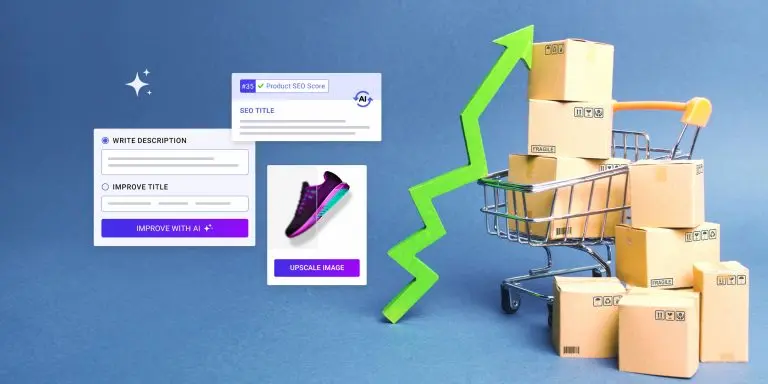Have you just started a dropshipping business? If so, one of your biggest challenges will be to make the company sustainable over the long-term. Unfortunately, over 90% of dropshipping businesses fail within the first few months because they lack the budget and resources to keep running.
You’ll generally need approximately $3,000 to get started, after which your monthly operational costs will drop to around $1,000 depending on how much you spend on advertising, the platforms you use, and, of course, your sales. If you don’t properly track and report your income and expenses, though, you won’t be able to accurately assess your financial health, forecast future revenue, and budget accordingly. This means you risk running out of funds down the line.
That’s why accounting in dropshipping is so crucial. Although keeping abreast of how much you spend and earn may seem straightforward, it can get complicated once you add in factors like taxes, compliance, and even international dropshipping. To help you along, here are a few accounting basics you need to know.
Table of Contents
Bookkeeping
Contrary to popular belief, bookkeeping isn’t the same thing as accounting. It involves carefully recording all your dropshipping business’ financial information, which you’ll then use to make informed decisions to keep your operations sustainable for longer. However, it will serve as the foundation for your more complex accounting efforts, which is why you’ll want to do it carefully. Here are a few key elements you’ll want to keep track of in your ledger.
- Assets: anything of value your business owns that generates revenue. One great example is your inventory, but assets can also be intangible, like your brand reputation.
- Liabilities: anything your business owes that is deducted from your revenue. That can include debts or obligations to suppliers and dropshipping platforms.
- Revenue: this refers to the money you earn from selling your inventory.
- Expenses: this refers to the money you spend to run your dropshipping business. As per this article The True Cost of Dropshipping, this can include supplier fees, return and marketing costs, and how much you spend to get a tax ID or business license.
Accurately tracking the above through bookkeeping is crucial for making precise accounting decisions. However, it can be challenging, especially since dropshipping businesses can receive a high volume of invoices in a short amount of time.
To streamline, you can outsource the process to professionals like freelance bookkeepers. You can also use automated bookkeeping software like Quickbooks rather than relying on spreadsheets if you want to keep things in-house.
Key accounting processes for dropshipping
Once you’ve got accurate financial data to work off of, it’s time to assess your dropshipping business’ true financial health and use the insights you gain to make long-term decisions. These are the accounting processes you’ll want to know about.
Revenue recognition
This process involves strategically deciding when to recognize the revenue you earn from your dropshipping store. It outlines what’s owed you once you’ve delivered products, even if it means the customers who received them haven’t been billed yet. That makes revenue recognition crucial: it will tell you exactly how much you have on hand at any given moment, helping you address accounts payable and receivable.
Accounts payable (AP) are a kind of short-term liability or debt your dropshipping business is likely to incur, as it refers to the amount you owe to suppliers who stock your inventory on credit. In contrast, accounts receivable (AR) is how much your customers owe you for purchasing from your store. However, it is considered a type of asset and is part of the revenue you can recognize.
It’s especially important to track AP and AR, given how you may accumulate what revenue recognition software SOFTRAX defines as unbilled AR. It refers to money you’ve earned from sales but hasn’t been billed to the customer yet and can occur due to delays in invoice generation. Accounting for unbilled AR is vital for determining if you need to remind customers to pay on time. Doing so will prevent revenue leakage, which can impact your dropshipping business’ financial health and affect your ability to promptly resolve your AP.
Inventory valuation
As its name suggests, this aspect of accounting will help you establish the current value of your inventory. It’s usually calculated by subtracting your inventory output, or the value of the products you sell, from your inventory input or how much it costs you to stock your store. There are a couple of ways to track inventory value.
The first is the first-in-first-out (FIFO) method, which involves treating the first inventory items you stocked as the first ones sold. Conversely, you can use the last-in-first-out (LIFO) method that assumes the last inventory items you purchase as the first ones you sell.
When choosing between FIFO and LIFO, your decision doesn’t need to align with how you actually manage your inventory. That means you shouldn’t feel compelled to move your newest inventory first if you opt for the LIFO method, for example. However, Investopedia finds that FIFO is considered more feasible for most companies because it’s typically not realistic to assume your dropshipping business operates by leaving its oldest inventory idle. Choose wisely: the IRS usually requires you to stick to a single method when filing your tax returns for your first year of operations.
It’s still important to value your inventory, even if the dropshipping business model doesn’t require you to directly hold stock. That’s because it helps you determine your costs of goods sold and therefore the current profitability of your dropshipping business. That way, you can see how many products you can afford to buy from your supplier at a given time. Doing so ensures seamless availability for customers, so you won’t end up selling items that you don’t actually have on hand. Aside from helping maintain customer trust in your brand, that also makes inventory valuation crucial for the following accounting processes.

Financial reporting
If you want to use accounting to generate insights for your business decisions, you need financial reports. With revenue recognition and inventory valuation, you can more accurately determine how much you’re earning, use that information to bolster your bottom line, and keep running your dropshipping business profitably for longer. These are the most important financial reports you’ll want to make:
- Revenue reports: created through revenue recognition, these detail the amount you earn from dropshipping sales, including the shipping and handling charges you bill customers and any cancellations, returns, or refunds they make.
- Expense reports: these list all the money you spend to run your dropshipping business. That includes fixed costs like your monthly payments to platforms like Shopify, as well as variable or changing costs like how much you spend on advertising every month.
- Profit and loss statements: these combine the insights from your revenue and expense reports to show you how much you’re actually making in a given time period, allowing you to identify possible revenue leakages and strategize how to boost profitability.
- Cash flow statements: these document how much money moves in and out of your business and when. That means you’ll always know if you have the money on hand to invest in strategies for business growth, such as by expanding your product offerings or using the new AI-powered Appscenic features we released to improve your store’s appearance and SEO rankings. Include cash conversion cycle metrics, which measure the time spent between paying your suppliers and making that money back through sales, to determine your business’ capability to stay financially viable.
Taxes
Of course, you’ll want to file your business taxes correctly, and the above accounting processes can help with that. Dropshipping taxes can vary depending on factors such as where you source your inventory and the methods you use to collect payment from customers. These are some of the taxes you may be subject to.
- Income tax: this depends on the gross income you earn from dropshipping. The percentage deducted is usually based on your quarterly or annual profits.
- Sales tax: this comes from the purchases customers make in your store. It will vary based on the states they’re from and whether you have a nexus, or physical presence, in that area.
- Customs duty tax: you’ll need to pay this if your dropshipping business uses overseas suppliers or ships internationally. It’s one of the biggest challenges we note in navigating the complexities of international dropshipping, as you’ll have to thoroughly research the customs regulations of the countries you operate in to accurately factor in the additional costs your business may incur.
The percentages deducted for taxes will vary. For example, nine US states, including Alaska and Wyoming, don’t charge income tax. If you need clarification on dropshipping taxes, it’s always wise to consult an accountant. You can also use automated tax software like Vertex to streamline your calculating and filing processes.
Read more: Understanding the Legal Risks of US Dropshipping
Budgeting
Once you’ve garnered accurate insights from bookkeeping and all the above accounting processes, you can accurately forecast your future revenue. That does more than tell you the state of your financial health—it can help you budget, too. By following the above accounting basics, you’ll know how many available dollars you have to spend and can give each one a realistic job that will help you grow your dropshipping operations even further.
In our comprehensive guide to starting a dropshipping business with Ecwid, we note that you should include allocating ample funds to pay for ongoing expenses like ecommerce transaction fees, marketing campaigns, legal services, and subscriptions for the apps you use to streamline your operations.
If you’re looking to expand your dropshipping business, you can also pay for additional product samples you can test to broaden your offerings. The goal is to have a cash flow of at least $1000 a month along with a little extra so you’re prepared for any unexpected circumstances, and these accounting basics can help you do just that.
Guest article written by Ruth Johnson











